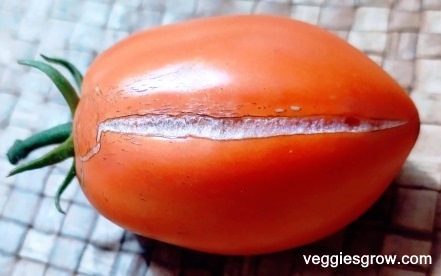Calcium is abundant in soil, and calcium deficiency is rarely seen in plants growing in their natural environment. Unfortunately, plants grown in greenhouses, containers, or hydroponic systems can easily be affected by calcium deficiency.
Symptoms of calcium deficiency
The main feature of calcium deficiency in plants is stunted growth. Calcium deficiency symptoms may be visible in vegetables, even if they are not visible in the leaves.
One of the most frequently encountered symptoms of calcium deficiency is blossom-end rot that affects tomatoes, peppers, and watermelon. In blossom-end-rot, a rotten looking large water-soaked dark brown-to-black leathery spot starts spreading from the end of the fruit that is not attached to the plant, which would have at one point been the tip of the blossom or flower.
Fruit cracking in tomatoes is also considered to be a symptom of calcium deficiency because calcium plays an important role in the growth of the skin of tomatoes and other vegetables.
Other symptoms of calcium deficiency that can be seen in vegetables are tipburn or the drying up of the tips of young leaves of vegetables, such as cabbage, onion, fennel, and potatoes, and also blackheart of celery, in which also young leaves dry-up.
In leaves, calcium deficiency shows up as the curling up of leaves towards the main vein. Areas of the leaf that don’t have enough calcium become stunted and areas of the leaf that are not affected start to curl-up as they grow because the growth is uneven.
Calcium deficiency can also make the roots of plants grow slower than usual and may eventually cause the roots to stop growing at all and turn brown, allowing the roots to become infected very easily.

Adding calcium to the soil or substrate is not enough
The most obvious way to prevent calcium deficiency is to add calcium to the soil or substrate. You can easily add calcium to your organic vegetable garden by adding dolomite or gypsum. into the soil or substrate.
Unfortunately, even when the amount of calcium needed by the plant is readily available in the soil or substrate, the plant may not be able to absorb enough calcium and transfer it into the growing parts of the plant that need it the most.
Despite this, the foliar application of calcium, in which calcium is sprayed directly on the leaves, can reduce symptoms of calcium deficiency to a certain extent.
Calcium moves from the soil into the plant along with water that the plant absorbs through its roots. If there isn’t enough water moving into the plant or if calcium is not available in the form that plants is able to absorb, your plants may not be able to get enough calcium.
Calcium once deposited in leaves can’t be transferred to newly growing parts of the plant, such as leaves, roots, or vegetables. This means that a growing plant must continuously be able to absorb calcium.
There are a few easy steps that you can follow to make sure that your plant can continue to absorb calcium so that it doesn’t suffer from calcium deficiency after you have added enough calcium into the soil or substrate.

How to help your plants absorb enough calcium
- Encourage sufficient root growth
Plants that have better root growth are better at absorbing calcium from the soil.
Growing vegetable plants in containers that are large enough to can help plant roots keep growing as needed. So, it’s always good to check the size of the container that vegetable plants should be grown in and plant accordingly.
If you are growing plants directly on the ground, you can make sure that you leave sufficient spacing between plants to encourage better root growth.
- Don’t add too much of nutrients
Adding too much nitrogen makes plants grow faster than they usually would, and the plant may not be able to absorb enough calcium to keep up with the rapid growth.
High levels of potassium, magnesium, and sodium can also cause calcium deficiency as these nutrients react with calcium and reduce the amount of calcium that is in the form that plants can absorb.
For these reasons, you should only add the correct amount of nutrients that the plant will need.
- Control the level of salinity
High levels of salinity can increase the chance of your plant developing calcium deficiency symptoms because this can lower the amount of water available for your plant to take up.
Providing proper drainage for your container-grown vegetables can stop salts from building up in the substrate and allow any salts that have collected to be washed away with each watering.
You must make sure that material you are using as substrate has been thoroughly cleaned and doesn’t have any salt residues remaining. This is very important if you are using cocopeat, as its raw form has a high content of salts.
- Don’t water your plants too much or too little
Watering your plants as much as they need allows your plants to absorb enough calcium along with the water that they take up, but that doesn’t mean that you should over-water your plants. Symptoms of calcium deficiency can also become more severe when the soil or substrate is too moist.
Large changes in the moisture levels of the soil or substrate can increase the chance of fruit cracking. This can be clearly seen in tomatoes, as they are more likely to crack after a period of rain.
The trick here is to decide on how often and how much you should water your plants by being vigilant about changes in your environment. Adaptively watering your container plants can allow them to have a consistent supply of water that does not affect the transport of water and calcium into your plant.
- Add mulch
Adding a few layers of mulch can protect your plants from being affected by sudden changes in the moisture levels of the soil or substrate.
- Provide enough ventilation
Plants that have enough ventilation and airflow are less likely to develop symptoms of calcium deficiency. Proper ventilation and airflow allow plants to carry-out photosynthesis at optimum levels, for which the plant must take up a constant supply of water, and calcium flows in along with water.
- Grow varieties that are less susceptible to calcium deficiency
Certain varieties of tomatoes and other vegetables are less likely to develop symptoms of calcium deficiency. Growing these varieties can allow you to grow your vegetables without worrying too much about how much calcium your plants are able to take up.
Calcium deficiency cannot be prevented just by adding more calcium into the soil or substrate. Considering that calcium is taken up by plants along with water, it is important to make sure that your plants can absorb the correct amount of water and that calcium is available in the form that can be taken up by plants.
Steps such as consistently watering, controlling the level of salinity, and preventing a sudden increase in the growth rate of your plants, can help your plants absorb the amount of calcium that they need.
How do you prevent your vegetable plants from developing symptoms of calcium deficiency? – Let us know in the comments


Excellent article – I had no idea!
Thank you!
Wow. This is going to be very helpful when planning my garden next year! Thanks.
Thank you. I’m glad you found it helpful.
Very informative blog. Live in NYC and had to resort to apartment gardening. I wrote a blog on how to start a garden indoors. Thanks for sharing these great garden tips.
Glad you enjoyed it! That’s ideal that you still started gardening despite living in an apartment in NYC.